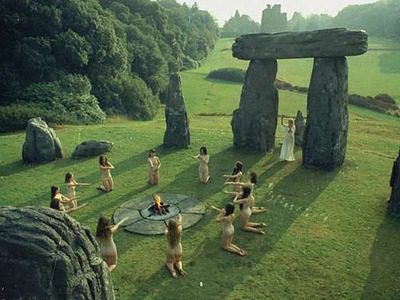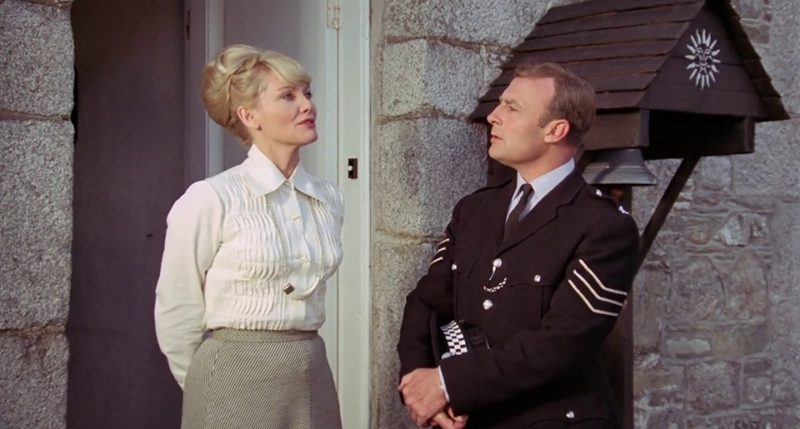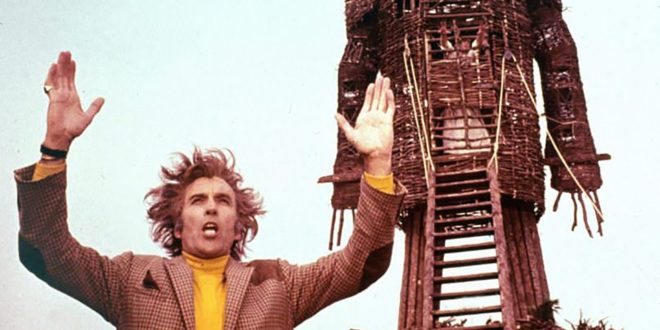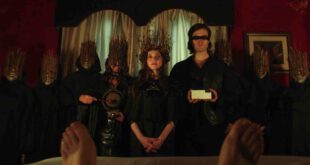Today we celebrate May Day; a day that honors springtime festivities embedded in ancient times. The present festivities in certain countries tend to focus more on celebrating a day for workers, but ancient traditions offered up the pagan rituals surrounding singing, dancing, and often human and animal sacrifices. All of that and more is depicted in Robin Hardy’s champion film, The Wicker Man – a movie masterpiece that went through hell and back to receive the worldwide recognition and cult status it deserves, showcasing Christopher Lee’s most powerful and distinctive role accompanied by one of the most shocking on-screen endings in film history.
Directed by Robin Hardy, The Wicker Man examines contrasting religious ideals and shows the true horrors that can be contained within human beings and their actions. While having a very intriguing plot, as a whole, this film has loose inspirations to both The Golden Bough by Sir. James George Frazer, and Ritual by David Pinner (with the depictions of ceremonies and activities to be fairly factual, as claimed by Hardy through his research).

The story takes place on the remote, fictitious island of Summerisle, where police officer sergeant Howie (Edward Woodward) has been called to locate a missing child, Rowan Morrison (Gerry Cowper). Upon arrival, none of the locals seem to know anything of the young girl, leading sergeant Howie in circles while coming to find that the islanders worship ancient pagan gods, leaving his Christian beliefs to feel threatened. The townsfolk appear to run rampant while openly having sex in public, perform bizarre ceremonies, and the ultimate of sacrifices that are held during their May Day celebration by their leader, Lord Summerisle (Christopher Lee).
Everything you know about horror (and really, film in general) gets tossed out the window, as The Wicker Man breaks through barriers and explores new territories in the fields of production, synopsis, and layout that has not been done before. Never has a film existed that incorporates such traditionally non-polar genres, creating something that shouldn’t work, but actually blends together quite nicely. At the forefront, it appears to be a mystery thriller, as sergeant Howie trots along to find the missing child, who no one seems to know anything about. But with its progression brings additives of horror, and even that of musicals, presenting numerous folk-based numbers that ring upbeat in nature. Perhaps the attraction of opposites is what makes The Wicker Man so unspeakably exciting while serving up intense subject matters.

To its core, The Wicker Man is rooted inside intellectualism, and displays many hefty appendages that all twine together. The focus shifts rather seamlessly, leading you along the story line with a sense of optimism, which quickly morphs into fearful uncertainty. The contrasting ups and downs of this film are so perplexing, yet pleasing to be a part of, while depicting grotesque imagery surrounded by a seemingly cheerful musical number that has you questioning what you are watching. It is all so bizarre and feels like a dizzy haze, as if you yourself have become entangled into this fantasy world that might actually exist somewhere out there. This approach proves to be successful, as not all genre films need to rely on gore and jump scares to deliver the goods, but rather engage your mind and allow you to problem solve along with the film.
With The Wicker Man, there is a lot to unfold within 88 minutes (depending on which version you are watching); from combative religious beliefs, to intense character interactions, along with severe gas lighting through a plot that involves the entire island and its residents. To uncover the amount of engaging context within this story almost feels like you’re playing detective yourself, revealing the mastery behind the production of this film, with each version showing something a little different. The three main versions consist of the theatrical, director’s cut, and the final cut, which was released on blu ray in 2013.

The final cut clocks in at around 94 minutes, being deemed the “middle” version between the 88 minute theatrical release and the 99 minute director’s cut. The original edit will likely never see the light of day, as it remains lost. But the 88 and 94 minute versions offer everything you need to see, without overkill. The theatrical cut has always felt the most complete, as some of the footage in the final cut deems excessive and diminishes suspense in regards to Christopher Lee’s character, as I feel he is shown way too soon in the film. Lord Summerisle is so powerful, that his seldom screen time in the first half amplifies his character’s intentions and the mystery that surrounds him.
With a phenomenal cast surrounded by excellent writing, cerebral metaphors, and a shocking ending that is not comparable to any other (which thankfully Hardy refused to change), The Wicker Man, I feel, will stand the test of cinematic time and remain on a pedestal in which genre fans often revere and return to. It is inspiring and insanely satisfying to enjoy by either watching the film or delving into its mesmerizing soundtrack. Be sure to celebrate May Day by partaking in this classic film and enjoying it throughout spring’s entirety.
The Wicker Man can be rented on various streaming platforms, along with its availability on blu ray and DVD.
 PopHorror Let's Get Scared
PopHorror Let's Get Scared




